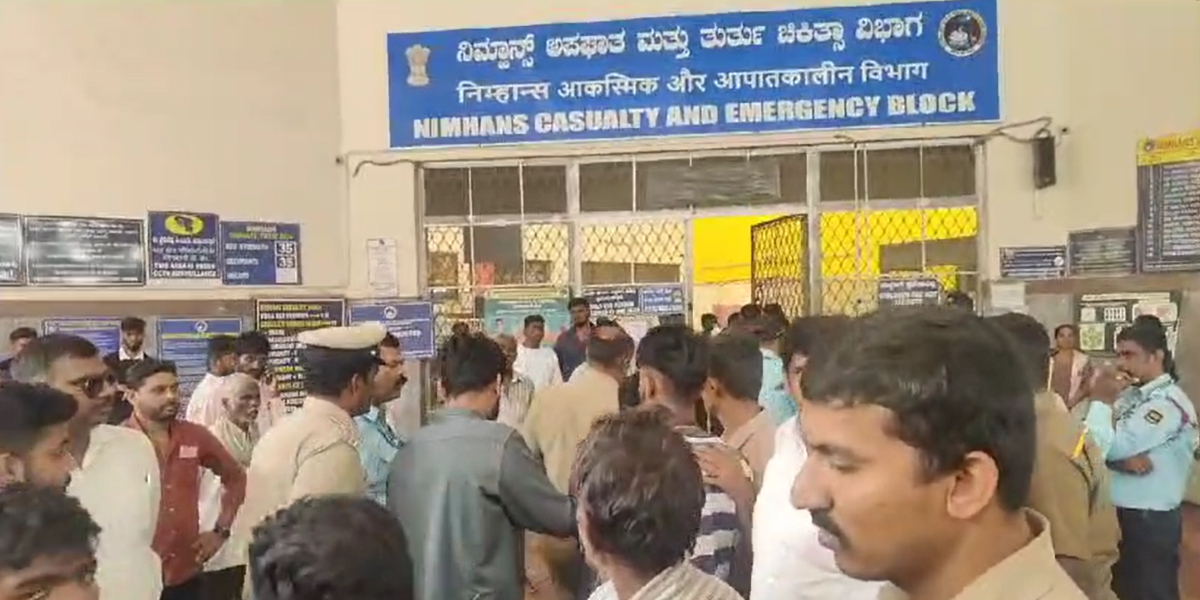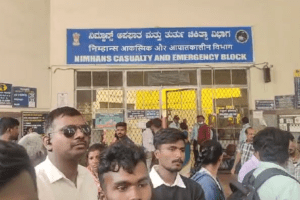The 18-month-old boy, who suffered a head injury, was rushed from Hassan to Bengaluru in just 1.4 hours via a 224-km green corridor, but it was in vain.

Cops from the local police station arrive at Nimhans Emergency and Casualty Ward. (Screengrab)
“There are no beds” — this is the parroted answer that a majority of families of patients, even those who come with severe head injuries, hear at the prestigious National Institute of Mental Health and Neurosciences (Nimhans) in Bengaluru.
On Wednesday, 29 November, tragedy struck when an 18-month-old boy from Chikkamagaluru lost his life following a severe head injury due to a shortage of beds.
In an unfortunate incident, Jyothi and Venkatesh’s 18-month-old child accidentally fell from a height of 10 ft, leaving the boy severely injured. The parents rushed him to the district hospital in Hassan, where doctors realised the severity of his condition and recommended transferring him to Nimhans in Bengaluru for specialised care.
In response, an extraordinary effort was made to transport the child to Bengaluru, involving the creation of a 224-km “green corridor” to facilitate rapid transit. Remarkably, the ambulance driver covered this distance in just 1 hour and 40 minutes.

People gathered outside the Emergency ward of Nimhans where the family was made to wait in an ambulance. (Screengrab)
Speaking to South First, family members of the child, who they did not wish to be named, said that upon reaching Nimhans, the couple faced a devastating setback. Despite the urgent nature of the child’s condition, they were informed that no beds were available. Desperate pleas from the parents for immediate treatment allegedly fell on deaf ears, as the authorities at Nimhans did not provide the needed assistance.
“Our child developed severe respiratory issues and he died in the corridor itself. We were made to wait in the ambulance for almost half an hour. They said there were no beds,” said one of the family members to South First.
Tragically, the child succumbed to his injuries on the hospital premises, a loss that has since ignited widespread anger and criticism of Nimhans. The family members have condemned the hospital for their alleged disregard for the emergency, which they believe directly contributed to the untimely death of the young boy.
Meanwhile, a Medico-Legal Case (MLC) report has been sent from Nimhans to the local Siddapura police station. This will, in turn, be sent to the Gonibeedu police station in Chikkamagaluru district. The Gonibeedu police were scheduled to visit Nimhans on Thursday to gather additional information.
Following this, a postmortem examination of the child will be conducted. After the postmortem, the child’s body will be released to the family. Family members have decided to protest against the hospital in front of Vidhana Soudha with the child’s body.
When South First spoke to doctors from Nimhans, they agreed, on condition of anonymity, that the institution is struggling with an insufficient number of beds to accommodate the massive influx of patients.
“The institute reportedly receives about 120-140 patients in its emergency ward daily, which is far more than its capacity. This overflow leads to patients, including those with head injuries, waiting for treatment, sometimes just seated around or lying on gurneys due to the bed shortage,” explained a senior doctor.
Doctors agreed that there have been instances where the lack of bed availability at Nimhans has led to dire consequences. In December 2022, there were media reports of a 15-year-old boy requiring emergency treatment for a stroke but was denied care due to the unavailability of ventilator beds.
Another incident involved a senior citizen with a brain haemorrhage who also couldn’t receive immediate surgery for the same reason. “These cases illustrate the critical nature of the emergency department’s overcrowding, often leading to patients being sent back despite their urgent need for specialised treatment,” said an official from the Health Department.
Meanwhile, senior doctors argued that the institute, being a tertiary care hospital, cannot admit every patient and must prioritise those needing specialised care. However, this means that some patients are inevitably left out. The doctors also noted that while Nimhans offers consultations to every patient, they often have to recommend other government hospitals for less serious cases.
Despite having 1,096 beds, including 44 ventilator beds, the institute struggles to meet the burgeoning demands, attributed partly to people seeking treatment for ailments not typically handled by Nimhans. The daily footfall at the hospital has increased over time, currently averaging around 2,000 people daily.
Karnataka Health Minister Dinesh Gundu Rao, speaking to the media in response to the death of the child and problems at Nimhans, agreed that the hospital is overcrowded and that there is pressure under which the facility operates. However, he also stressed the need for improvements.
“It is too crowded. The authorities are ensuring quality treatment, despite the pressure. We have to bring down their pressure,” he said. Gundu Rao also promised to gather more information about the circumstances leading to the child’s death, indicating an investigation into the matter.
Doctors at Nimhans suggest that hospitals like Victoria and other government hospitals must have round-the-clock neurological and neurosurgical emergencies. This would take some pressure off Nimhans and provide more localised care for treatable conditions.
Additionally, there’s a call for district and taluk hospitals to improve their infrastructure and manpower, which would reduce the necessity for patients from far-off places to seek primary treatment at Nimhans, doctors explained.

Jul 27, 2024

Jul 26, 2024

Jul 26, 2024

Jul 26, 2024

Jul 26, 2024

Jul 26, 2024